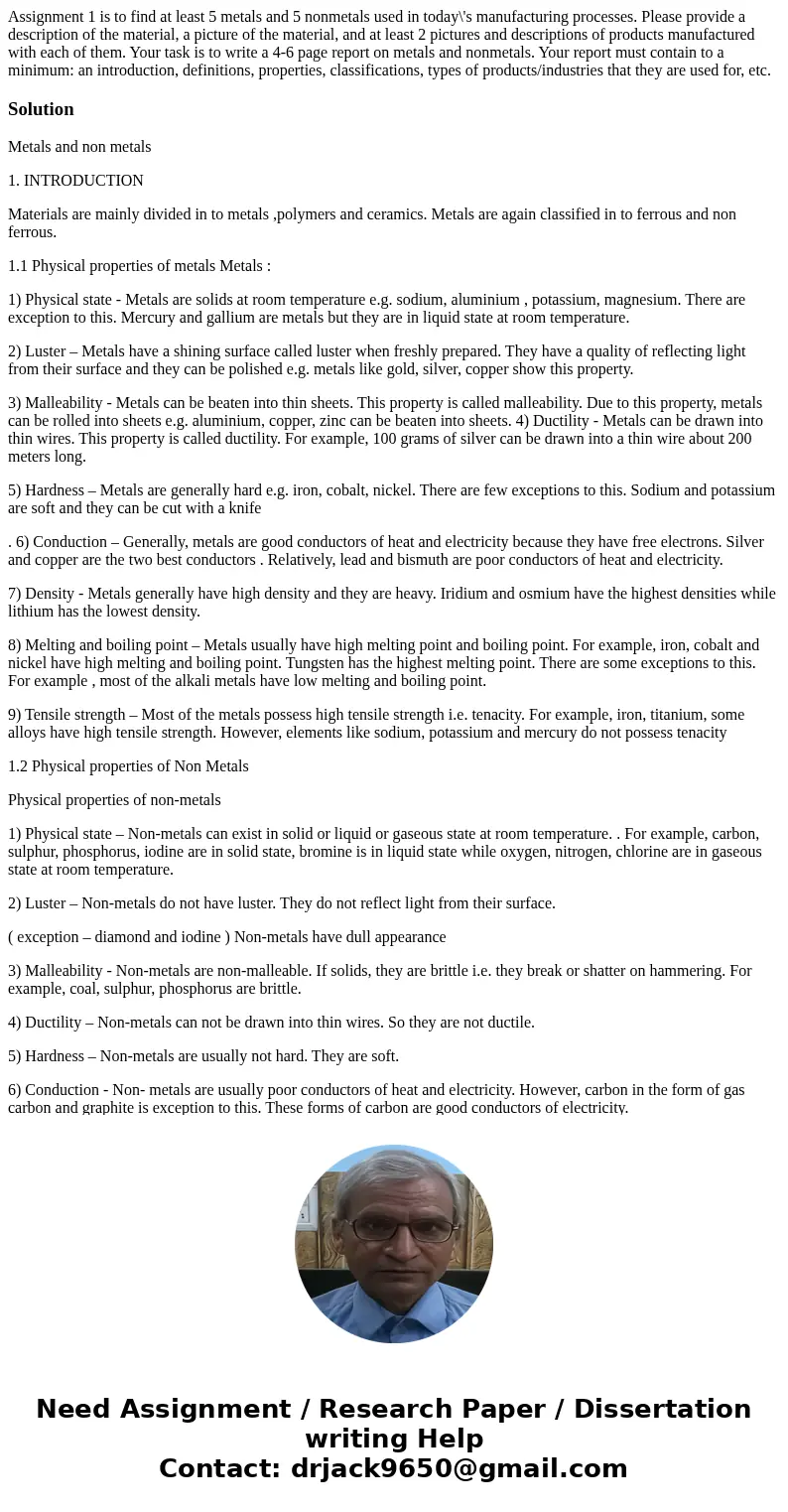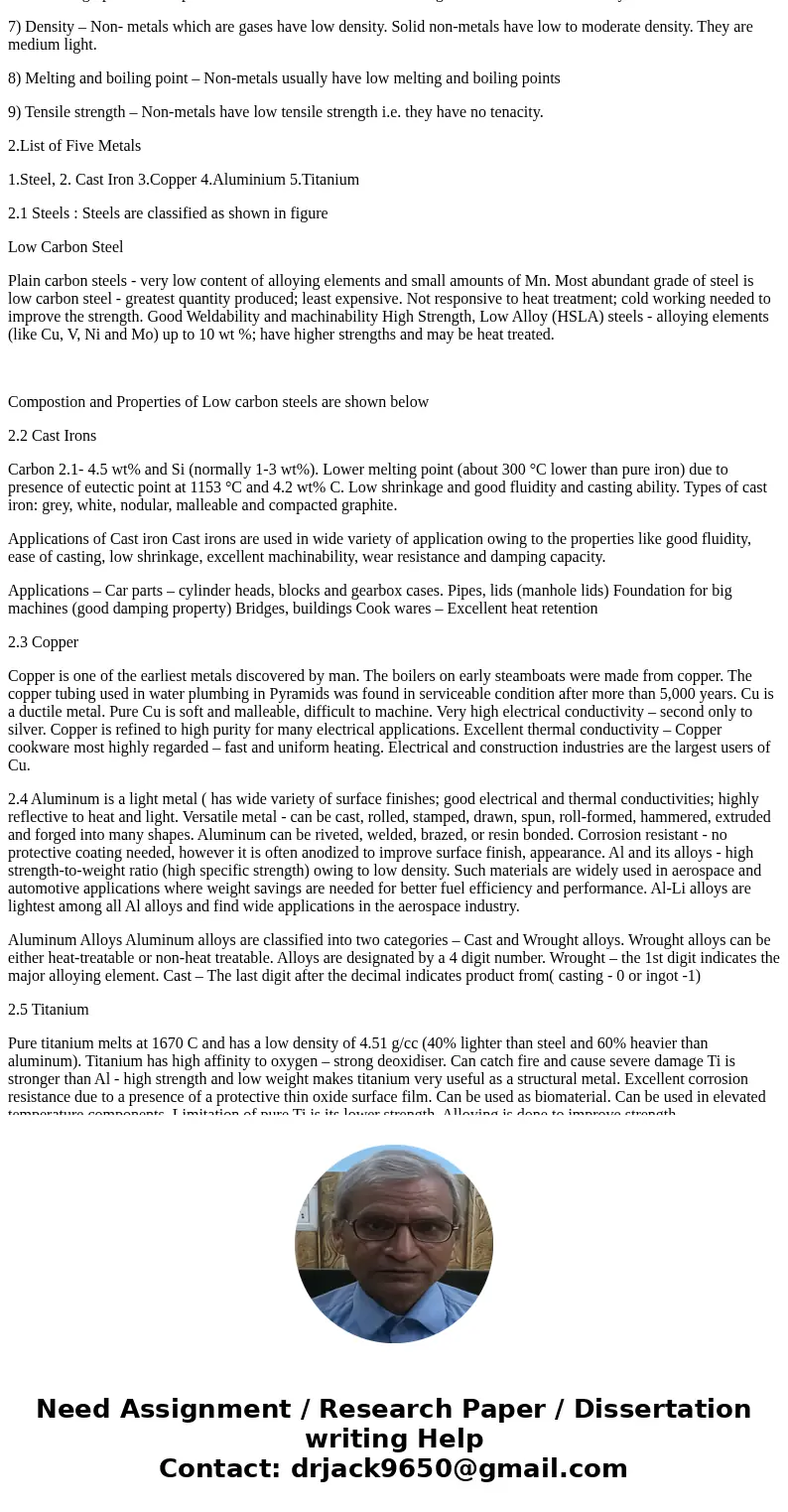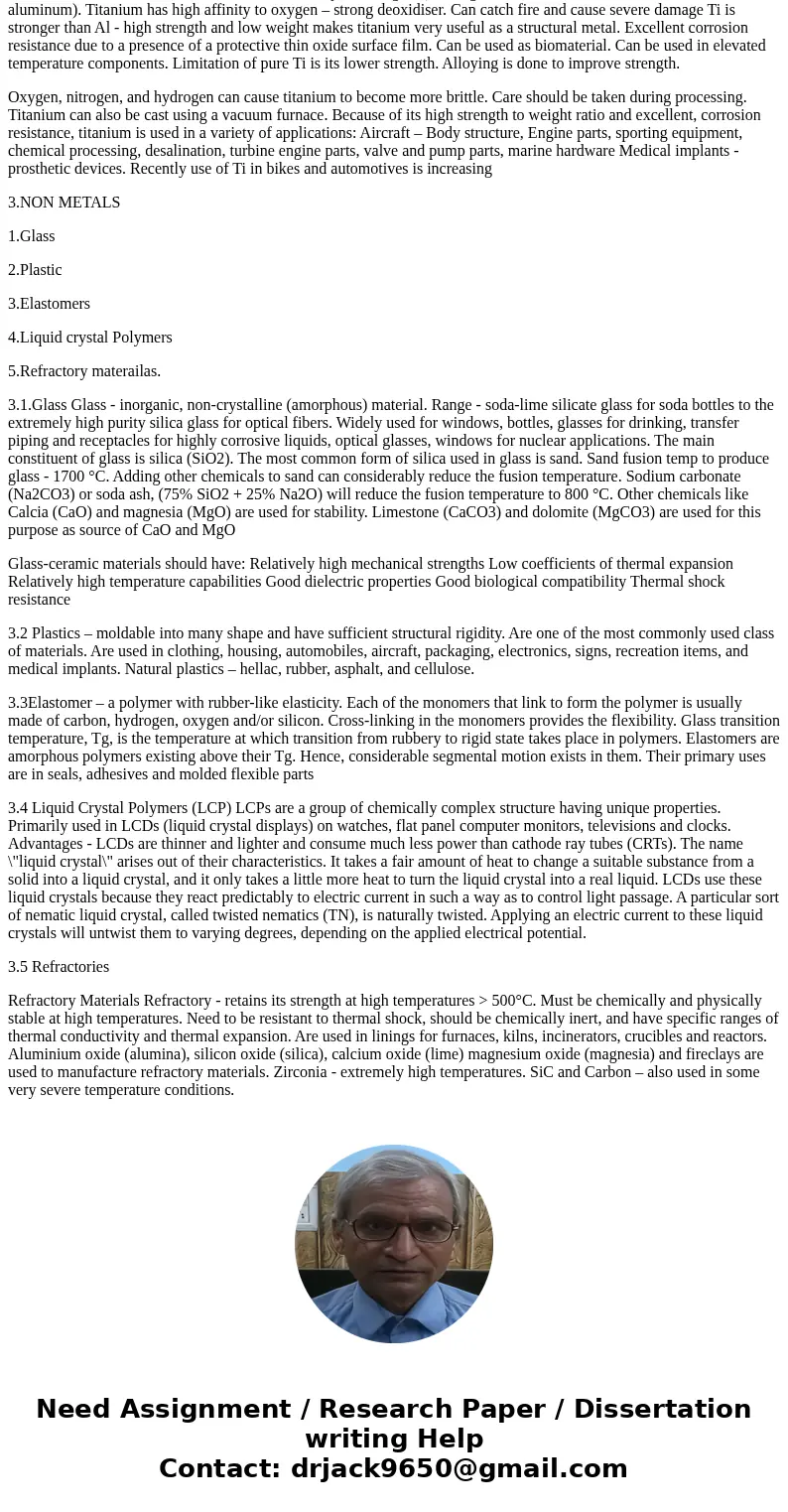Assignment 1 is to find at least 5 metals and 5 nonmetals us
Solution
Metals and non metals
1. INTRODUCTION
Materials are mainly divided in to metals ,polymers and ceramics. Metals are again classified in to ferrous and non ferrous.
1.1 Physical properties of metals Metals :
1) Physical state - Metals are solids at room temperature e.g. sodium, aluminium , potassium, magnesium. There are exception to this. Mercury and gallium are metals but they are in liquid state at room temperature.
2) Luster – Metals have a shining surface called luster when freshly prepared. They have a quality of reflecting light from their surface and they can be polished e.g. metals like gold, silver, copper show this property.
3) Malleability - Metals can be beaten into thin sheets. This property is called malleability. Due to this property, metals can be rolled into sheets e.g. aluminium, copper, zinc can be beaten into sheets. 4) Ductility - Metals can be drawn into thin wires. This property is called ductility. For example, 100 grams of silver can be drawn into a thin wire about 200 meters long.
5) Hardness – Metals are generally hard e.g. iron, cobalt, nickel. There are few exceptions to this. Sodium and potassium are soft and they can be cut with a knife
. 6) Conduction – Generally, metals are good conductors of heat and electricity because they have free electrons. Silver and copper are the two best conductors . Relatively, lead and bismuth are poor conductors of heat and electricity.
7) Density - Metals generally have high density and they are heavy. Iridium and osmium have the highest densities while lithium has the lowest density.
8) Melting and boiling point – Metals usually have high melting point and boiling point. For example, iron, cobalt and nickel have high melting and boiling point. Tungsten has the highest melting point. There are some exceptions to this. For example , most of the alkali metals have low melting and boiling point.
9) Tensile strength – Most of the metals possess high tensile strength i.e. tenacity. For example, iron, titanium, some alloys have high tensile strength. However, elements like sodium, potassium and mercury do not possess tenacity
1.2 Physical properties of Non Metals
Physical properties of non-metals
1) Physical state – Non-metals can exist in solid or liquid or gaseous state at room temperature. . For example, carbon, sulphur, phosphorus, iodine are in solid state, bromine is in liquid state while oxygen, nitrogen, chlorine are in gaseous state at room temperature.
2) Luster – Non-metals do not have luster. They do not reflect light from their surface.
( exception – diamond and iodine ) Non-metals have dull appearance
3) Malleability - Non-metals are non-malleable. If solids, they are brittle i.e. they break or shatter on hammering. For example, coal, sulphur, phosphorus are brittle.
4) Ductility – Non-metals can not be drawn into thin wires. So they are not ductile.
5) Hardness – Non-metals are usually not hard. They are soft.
6) Conduction - Non- metals are usually poor conductors of heat and electricity. However, carbon in the form of gas carbon and graphite is exception to this. These forms of carbon are good conductors of electricity.
7) Density – Non- metals which are gases have low density. Solid non-metals have low to moderate density. They are medium light.
8) Melting and boiling point – Non-metals usually have low melting and boiling points
9) Tensile strength – Non-metals have low tensile strength i.e. they have no tenacity.
2.List of Five Metals
1.Steel, 2. Cast Iron 3.Copper 4.Aluminium 5.Titanium
2.1 Steels : Steels are classified as shown in figure
Low Carbon Steel
Plain carbon steels - very low content of alloying elements and small amounts of Mn. Most abundant grade of steel is low carbon steel - greatest quantity produced; least expensive. Not responsive to heat treatment; cold working needed to improve the strength. Good Weldability and machinability High Strength, Low Alloy (HSLA) steels - alloying elements (like Cu, V, Ni and Mo) up to 10 wt %; have higher strengths and may be heat treated.
Compostion and Properties of Low carbon steels are shown below
2.2 Cast Irons
Carbon 2.1- 4.5 wt% and Si (normally 1-3 wt%). Lower melting point (about 300 °C lower than pure iron) due to presence of eutectic point at 1153 °C and 4.2 wt% C. Low shrinkage and good fluidity and casting ability. Types of cast iron: grey, white, nodular, malleable and compacted graphite.
Applications of Cast iron Cast irons are used in wide variety of application owing to the properties like good fluidity, ease of casting, low shrinkage, excellent machinability, wear resistance and damping capacity.
Applications – Car parts – cylinder heads, blocks and gearbox cases. Pipes, lids (manhole lids) Foundation for big machines (good damping property) Bridges, buildings Cook wares – Excellent heat retention
2.3 Copper
Copper is one of the earliest metals discovered by man. The boilers on early steamboats were made from copper. The copper tubing used in water plumbing in Pyramids was found in serviceable condition after more than 5,000 years. Cu is a ductile metal. Pure Cu is soft and malleable, difficult to machine. Very high electrical conductivity – second only to silver. Copper is refined to high purity for many electrical applications. Excellent thermal conductivity – Copper cookware most highly regarded – fast and uniform heating. Electrical and construction industries are the largest users of Cu.
2.4 Aluminum is a light metal ( has wide variety of surface finishes; good electrical and thermal conductivities; highly reflective to heat and light. Versatile metal - can be cast, rolled, stamped, drawn, spun, roll-formed, hammered, extruded and forged into many shapes. Aluminum can be riveted, welded, brazed, or resin bonded. Corrosion resistant - no protective coating needed, however it is often anodized to improve surface finish, appearance. Al and its alloys - high strength-to-weight ratio (high specific strength) owing to low density. Such materials are widely used in aerospace and automotive applications where weight savings are needed for better fuel efficiency and performance. Al-Li alloys are lightest among all Al alloys and find wide applications in the aerospace industry.
Aluminum Alloys Aluminum alloys are classified into two categories – Cast and Wrought alloys. Wrought alloys can be either heat-treatable or non-heat treatable. Alloys are designated by a 4 digit number. Wrought – the 1st digit indicates the major alloying element. Cast – The last digit after the decimal indicates product from( casting - 0 or ingot -1)
2.5 Titanium
Pure titanium melts at 1670 C and has a low density of 4.51 g/cc (40% lighter than steel and 60% heavier than aluminum). Titanium has high affinity to oxygen – strong deoxidiser. Can catch fire and cause severe damage Ti is stronger than Al - high strength and low weight makes titanium very useful as a structural metal. Excellent corrosion resistance due to a presence of a protective thin oxide surface film. Can be used as biomaterial. Can be used in elevated temperature components. Limitation of pure Ti is its lower strength. Alloying is done to improve strength.
Oxygen, nitrogen, and hydrogen can cause titanium to become more brittle. Care should be taken during processing. Titanium can also be cast using a vacuum furnace. Because of its high strength to weight ratio and excellent, corrosion resistance, titanium is used in a variety of applications: Aircraft – Body structure, Engine parts, sporting equipment, chemical processing, desalination, turbine engine parts, valve and pump parts, marine hardware Medical implants - prosthetic devices. Recently use of Ti in bikes and automotives is increasing
3.NON METALS
1.Glass
2.Plastic
3.Elastomers
4.Liquid crystal Polymers
5.Refractory materailas.
3.1.Glass Glass - inorganic, non-crystalline (amorphous) material. Range - soda-lime silicate glass for soda bottles to the extremely high purity silica glass for optical fibers. Widely used for windows, bottles, glasses for drinking, transfer piping and receptacles for highly corrosive liquids, optical glasses, windows for nuclear applications. The main constituent of glass is silica (SiO2). The most common form of silica used in glass is sand. Sand fusion temp to produce glass - 1700 °C. Adding other chemicals to sand can considerably reduce the fusion temperature. Sodium carbonate (Na2CO3) or soda ash, (75% SiO2 + 25% Na2O) will reduce the fusion temperature to 800 °C. Other chemicals like Calcia (CaO) and magnesia (MgO) are used for stability. Limestone (CaCO3) and dolomite (MgCO3) are used for this purpose as source of CaO and MgO
Glass-ceramic materials should have: Relatively high mechanical strengths Low coefficients of thermal expansion Relatively high temperature capabilities Good dielectric properties Good biological compatibility Thermal shock resistance
3.2 Plastics – moldable into many shape and have sufficient structural rigidity. Are one of the most commonly used class of materials. Are used in clothing, housing, automobiles, aircraft, packaging, electronics, signs, recreation items, and medical implants. Natural plastics – hellac, rubber, asphalt, and cellulose.
3.3Elastomer – a polymer with rubber-like elasticity. Each of the monomers that link to form the polymer is usually made of carbon, hydrogen, oxygen and/or silicon. Cross-linking in the monomers provides the flexibility. Glass transition temperature, Tg, is the temperature at which transition from rubbery to rigid state takes place in polymers. Elastomers are amorphous polymers existing above their Tg. Hence, considerable segmental motion exists in them. Their primary uses are in seals, adhesives and molded flexible parts
3.4 Liquid Crystal Polymers (LCP) LCPs are a group of chemically complex structure having unique properties. Primarily used in LCDs (liquid crystal displays) on watches, flat panel computer monitors, televisions and clocks. Advantages - LCDs are thinner and lighter and consume much less power than cathode ray tubes (CRTs). The name \"liquid crystal\" arises out of their characteristics. It takes a fair amount of heat to change a suitable substance from a solid into a liquid crystal, and it only takes a little more heat to turn the liquid crystal into a real liquid. LCDs use these liquid crystals because they react predictably to electric current in such a way as to control light passage. A particular sort of nematic liquid crystal, called twisted nematics (TN), is naturally twisted. Applying an electric current to these liquid crystals will untwist them to varying degrees, depending on the applied electrical potential.
3.5 Refractories
Refractory Materials Refractory - retains its strength at high temperatures > 500°C. Must be chemically and physically stable at high temperatures. Need to be resistant to thermal shock, should be chemically inert, and have specific ranges of thermal conductivity and thermal expansion. Are used in linings for furnaces, kilns, incinerators, crucibles and reactors. Aluminium oxide (alumina), silicon oxide (silica), calcium oxide (lime) magnesium oxide (magnesia) and fireclays are used to manufacture refractory materials. Zirconia - extremely high temperatures. SiC and Carbon – also used in some very severe temperature conditions.



 Homework Sourse
Homework Sourse